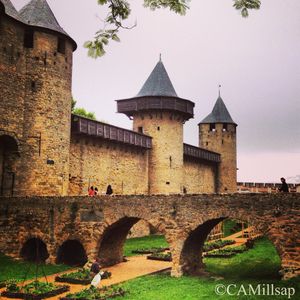Travel: A Day in Carcassonne, France
When you first see the medieval walled Cité' of Carcassonne, depending on the direction from which you approach, it can appear unexpectedly on the landscape. Like the magic castle in a storybook.
The high stone walls and tall towers wrap ribbonlike around the rocky top of the hill and the Pont Vieux, a 600-year-old bridge, connects the old Cité' with the 'newer' town below with a series of graceful stone arches.
The Romans laid the first stones of the walls--some of which are still visible. By the 13th Century Carcassonne’s gates were protecting a castle and, later, the architecturally significant Basilica Saint-Nazaire.
Surviving countless sieges and wars, the old Cité' of Carcassonne eventually fell into disrepair, eventually becoming a source of stone for newer construction, and by 1849 was slated to be demolished. But the influential mayor organized a monumental and controversial effort project to rebuild and preserve the cite, hiring a noted architect to oversee the project. Some creative license was taken, slate tiles were added and things were not put back exactly as they had been, but the oldest part of Carcassonne was saved. (And, interestingly, it was specifically designed to draw tourists.) Work continued until 1910.
In 1997 Carcassonne was listed as a UNESCO world heritage site and that same year the city’s most prestigious hotel, the Hôtel de la Cité which offers a spectacular view that stretches to the distant Pyranees, was opened by the Orient Express Group.
In the high season the crowd in Carcassonne can be shoulder-to-shoulder, but in mid-June I had all the room I needed. It was the last day of school and children on an end-of-the-year class excursion laughed as they ran from one thing to another. Someone spotted a pop star in town for the annual Carcassonne Music Festival and they flocked to wave and peer through the windows as they watched as his chauffeured Lamborghini edge through the fortified city’s double gates.
Shops of all kinds line the narrow cobblestoned streets and I stopped to buy colorful espadrilles, the iconic flat rope-soled canvas shoes made in the South of France, for my daughters. I bought a pair for myself and a bag of sweet French nougat to bring home.
As I spent my day in Carcassonne, I watched the personality of city change and shift, first gleaming in the bright sun and then at night, Illuminated by lights placed strategically along the outer walls, become shadowed and mysterious.
A couple of weeks after my return from France, browsing through an antique store, I stumbled upon a “Lady’s” travel book written in 1907 about the Languedoc region of France that was written. It is the highly-romanticized story of two young female travelers, flowery and feminine but, in a way, also a bit radical. At that time, at the turn of the last century, few women had the freedom to travel so independently and the adventures of the two cousins as they toured the countryside must have been appealing to readers. In the chapter on Carcassonne one of the young travelers is inspired by the ancient towers and finds a spot sheltered by the old walls to sit and write in her journal.
What made me smile was a notation in the Rick Steves guidebook I’d read prior to my visit. In it he mentions a day spent in Carcassonne when he was a teenager, and he included the notes he’d made that day while sitting on one of the ramparts. It seems no one is immune. English author, Kate Mosse, whose 2007 bestselling novel Labyrinth was set in Carcassonne and still draws thousands of readers to the Cité' each year, has a house in the area and she admits to falling under its spell. Walt Disney is said to have visited, coming away with the inspiration for his Sleeping Beauty castle.
Sure there is a touristy side to what has become of the old Cité'. Toy swords and refrigerator magnets abound. But beautiful, evocative, places like Carcassonne, imbued with an ancient and intimate history of the men, women and children who once lived there, draw us in. And in that way Carcassonne is impossible to resist. Romance is mortared into the very walls of the place
Cheryl-Anne Millsap is a travel writer whose audio essays can be heard on Spokane Public Radio and on public radio stations across the country. She is the author of ‘Home Planet: A Life in Four Seasons’ and can be reached at catmillsap@gmail.com
